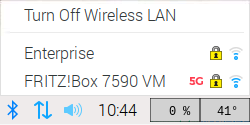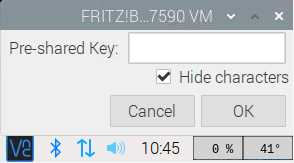https://github.com/qengineering/rpi_64-bit_zero-2-image
Raspberry Pi Zero 2 W 64-bit OS image with OpenCV, TensorFlow Lite and ncnn Framework.
https://github.com/qengineering/rpi_64-bit_zero-2-image
arm7 armv7 ncnn ncnn-framework opencv4 rasberry-pi-zero-2 raspberry-pi-zero-2-w sd-card-image tensorflow-lite
Last synced: 7 months ago
JSON representation
Raspberry Pi Zero 2 W 64-bit OS image with OpenCV, TensorFlow Lite and ncnn Framework.
- Host: GitHub
- URL: https://github.com/qengineering/rpi_64-bit_zero-2-image
- Owner: Qengineering
- License: bsd-3-clause
- Created: 2021-11-23T11:25:35.000Z (almost 4 years ago)
- Default Branch: main
- Last Pushed: 2022-02-17T10:56:01.000Z (over 3 years ago)
- Last Synced: 2025-01-26T03:45:46.783Z (8 months ago)
- Topics: arm7, armv7, ncnn, ncnn-framework, opencv4, rasberry-pi-zero-2, raspberry-pi-zero-2-w, sd-card-image, tensorflow-lite
- Homepage: https://qengineering.eu/install-64-os-on-raspberry-pi-zero-2.html
- Size: 11.7 KB
- Stars: 39
- Watchers: 5
- Forks: 7
- Open Issues: 0
-
Metadata Files:
- Readme: README.md
- License: LICENSE
Awesome Lists containing this project
README
# Raspbeery Pi Zero 2 64-bit OS image

## A Raspberry Pi Zero 2 64-bit OS Bullseye with OpenCV, TensorFlow Lite and ncnn
[](https://opensource.org/licenses/BSD-3-Clause)
## Installation.
- Get a SD-card which will hold the image (min 16 GB).
- Download the image RPi_64OS_Zero_2.xz (1.7 GByte!) from our [Gdrive](https://drive.google.com/file/d/1VPpalGylbriNlVggF35PeVApsVFXwlHv/view?usp=sharing) site.
- Flash the image on the SD-card with the [Imager](https://www.raspberrypi.org/software/) or [balenaEtcher](https://www.balena.io/etcher/).
- Insert the SD-card in your Raspberry Pi Zero 2.
- Wait a few minutes, while the image will expand to the full size of your SD card.
- No WiFi installed. Password: ***3.14***
------------
## Remarks.
* You can [overclock the Raspberry Pi Zero 2](https://qengineering.eu/install-64-os-on-raspberry-pi-zero-2.html) if your SD-card is not too worn out. 1200 MHz is no problem. Most deep learning examples even work at 1300 MHz.
* If you are in need of extra space, you can delete the opencv and the opencv_contrib folder from the SD-card. There are no longer needed since all libraries are placed in the /usr/local directory.
* Please note, the Raspberry Pi Zero 2 is a very new device. Lost of (software) updates can be expected in the coming months.
* We commit several deep learning benchmarks. Read all about them at our [site](https://qengineering.eu/install-64-os-on-raspberry-pi-zero-2.html)
* As explained on the website, you have only 100 MB of free RAM for your applications left once the 64-bit Bullseye is loaded. To enlarge the amount of RAM to more practical sizes, we use a large swapping space. It will wear your SD card when used intensively. It also slows down the performance, as you can see in the graph below. The 64-bit Ubuntu server was faster, but it doesn't have a graphical desktop. Only a terminal input. And for those unfamiliar with Ubuntu, the desktop is only possible with 4 GB of RAM onboard.

------------
## Pre-installed frameworks.
- [OpenCV](https://qengineering.eu/deep-learning-with-opencv-on-raspberry-pi-4.html) 4.5.4
- [ncnn](https://qengineering.eu/install-ncnn-on-raspberry-pi-4.html) 20210124
- [TensorFlow-Lite](https://qengineering.eu/install-tensorflow-2-lite-on-raspberry-64-os.html) 2.6.0
------------
## WiFi.
Since everyone has a unique password on their WiFi connection, we have not activated the WiFi.
To enable the wireless LAN follow the next steps:
1) Left click on the Ethernet symbol.

2) Click "Turn on wireless LAN", and wait a few seconds. Your RPi will scan for available networks.

3) Left click again on the Ethernet symbol and choose your network.

4) Give your key, and wait a couple of seconds to let the RPi establish the connection.

5) Success!

------------
[](https://www.paypal.com/cgi-bin/webscr?cmd=_s-xclick&hosted_button_id=CPZTM5BB3FCYL)